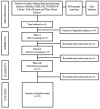The Relationship Between Physical Activity and Mental Health Among Individuals With Spinal Cord Injury: Protocol for a Scoping Review
- PMID: 38865699
- PMCID: PMC11208830
- DOI: 10.2196/56081
The Relationship Between Physical Activity and Mental Health Among Individuals With Spinal Cord Injury: Protocol for a Scoping Review
Abstract
Background: Spinal cord injury (SCI) is a devastating condition that often leads to significant impairments in physical function, leading to disability and mental health disorders. Hence, understanding the prevalence of SCI and the relationship between physical activity and mental health in individuals with SCI is crucial for informing rehabilitation strategies and optimizing outcomes.
Objective: This study aims to comprehensively analyze existing research on the link between physical activity and mental health and identify the level of physical activity and mental health status, the barriers to physical activity, and SCI's impacts on psychological well-being in individuals with SCI.
Methods: An electronic search strategy will be used to identify prevalence studies published since 1993 in health-related databases such as PubMed, MEDLINE, COCHRANE Library, and Wiley Library using the following query: "Spinal Cord Injury" OR "Paraplegia" OR "Tetraplegia" AND "Physical Activity" OR "Exercise" AND "Mental Health" OR "Mental Illness" OR "Mental Disorder." Bibliographies of primary studies and review articles meeting the inclusion criteria will be searched manually to identify further eligible studies. The risk of bias in the included studies will be appraised using the Joanna Briggs Institute checklist for prevalence studies by 2 review authors. Any disagreement will be resolved by reaching a consensus.
Results: Funding was received in October 2023, data collection will commence in July 2024, and the results are expected by 2025. We will summarize the selection of the eligible studies using a flowchart. The data from the studies will be extracted and tabulated. This scoping review will be published in a peer-reviewed journal in accordance with PRISMA-ScR (Preferred Reporting Items for Systematic Reviews and Meta-Analyses extension for Scoping Reviews) guidelines.
Conclusions: This scoping review underscores the complex relationship between physical activity and mental health among individuals with SCI, highlighting the level of physical activity and mental health status, barriers to physical activity engagement, and psychological implications. Understanding these dynamics is crucial in devising tailored interventions aimed at enhancing mental well-being. This synthesis of evidence emphasizes the need for personalized strategies to promote physical activity, addressing unique challenges faced by this population to foster improved mental health outcomes and overall quality of life.
Trial registration: Open Science Framework osf.io/ugx7d; https://osf.io/ugx7d/.
International registered report identifier (irrid): PRR1-10.2196/56081.
Keywords: SCI; access barriers; depression; disability; effectiveness; exercise; exercise interventions; impairments; mental health; mobility; mobility limitations; physical activity; physical function; prevalence; psychological outcomes; quality of life; scoping review; spinal cord injury; well-being.
©Winslet Ong, Noor Arfa Omar, Asfarina Zanudin, Muhamad Faiz Alias, Lim Hui Wen, Angel Thang Xue Ee, Nor Azlin Mohd Nordin, Haidzir Manaf, Basri Husin, Mahadir Ahmad, Hafifi Hisham. Originally published in JMIR Research Protocols (https://www.researchprotocols.org), 12.06.2024.
Conflict of interest statement
Conflicts of Interest: None declared.
Figures
Similar articles
-
Characteristics of activity-based therapy interventions for people living with spinal cord injury or disease across the continuum of care: a scoping review protocol.BMJ Open. 2020 Jul 23;10(7):e040014. doi: 10.1136/bmjopen-2020-040014. BMJ Open. 2020. PMID: 32709658 Free PMC article.
-
Access to Health Care and Use of Health Care Services Among Males in Africa: Protocol for a Scoping Review.JMIR Res Protoc. 2025 Jan 31;14:e52351. doi: 10.2196/52351. JMIR Res Protoc. 2025. PMID: 39889277 Free PMC article.
-
Assessing and Enhancing Nutrition and Physical Activity Environments in Early Childhood Education and Care Centers: Scoping Review of eHealth Tools.JMIR Pediatr Parent. 2025 Jan 22;8:e68372. doi: 10.2196/68372. JMIR Pediatr Parent. 2025. PMID: 39841984 Free PMC article. Review.
-
Primary Tumors of the Brain and Central Nervous System in Adults and Children in Sub-Saharan Africa: Protocol for a Scoping Review.JMIR Res Protoc. 2025 Apr 24;14:e66978. doi: 10.2196/66978. JMIR Res Protoc. 2025. PMID: 40273436 Free PMC article.
-
Cognitive and physical impairment in spinal cord injury: A scoping review and call for new understanding.J Spinal Cord Med. 2023 May;46(3):343-366. doi: 10.1080/10790268.2022.2134634. Epub 2022 Nov 28. J Spinal Cord Med. 2023. PMID: 36441038 Free PMC article.
Cited by
-
The impact of positive activities on mental health: the mediating role of positive emotion.Front Public Health. 2024 Dec 10;12:1474544. doi: 10.3389/fpubh.2024.1474544. eCollection 2024. Front Public Health. 2024. PMID: 39720811 Free PMC article.
References
-
- Coupaud S, McLean AN, Lloyd S, Allan DB. Predicting patient-specific rates of bone loss at fracture-prone sites after spinal cord injury. Disabil Rehabil. 2012;34(26):2242–2250. doi: 10.3109/09638288.2012.681831. https://core.ac.uk/reader/6170259?utm_source=linkout - DOI - PubMed
-
- Ramadan WS, Abdel-Hamid GA, Al-Karim S, Abbas AT. Histological, immunohistochemical and ultrastructural study of secondary compressed spinal cord injury in a rat model. Folia Histochem Cytobiol. 2017;55(1):11–20. doi: 10.5603/FHC.a2017.0001. https://journals.viamedica.pl/folia_histochemica_cytobiologica/article/v... VM/OJS/J/46914 - DOI - PubMed
-
- Moslavac S, Dzidić I, Kejla Z. Neurological outcome in road traffic accidents with spinal cord injury. Coll Antropol. 2008 Jun;32(2):583–586. - PubMed
-
- Chen Y, Tang Y, Vogel LC, Devivo MJ. Causes of spinal cord injury. Top Spinal Cord Inj Rehabil. 2013;19(1):1–8. doi: 10.1310/sci1901-1. https://europepmc.org/abstract/MED/23678280 - DOI - PMC - PubMed
-
- Zhang Z, Wu Y, Wang F, Wang W. Traumatic spinal cord injury caused by low falls and high falls: a comparative study. J Orthop Surg Res. 2021 Mar 27;16(1):222. doi: 10.1186/s13018-021-02379-5. https://josr-online.biomedcentral.com/articles/10.1186/s13018-021-02379-5 10.1186/s13018-021-02379-5 - DOI - DOI - PMC - PubMed
MeSH terms
LinkOut - more resources
Full Text Sources
Medical
Miscellaneous


